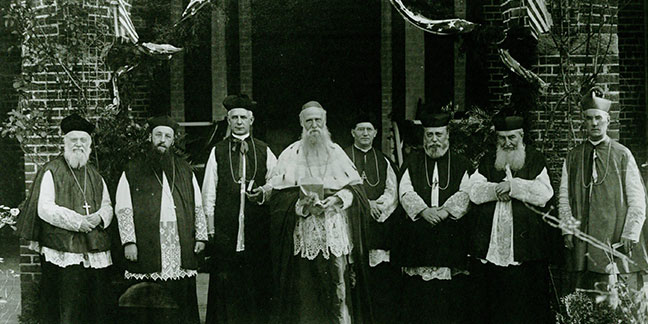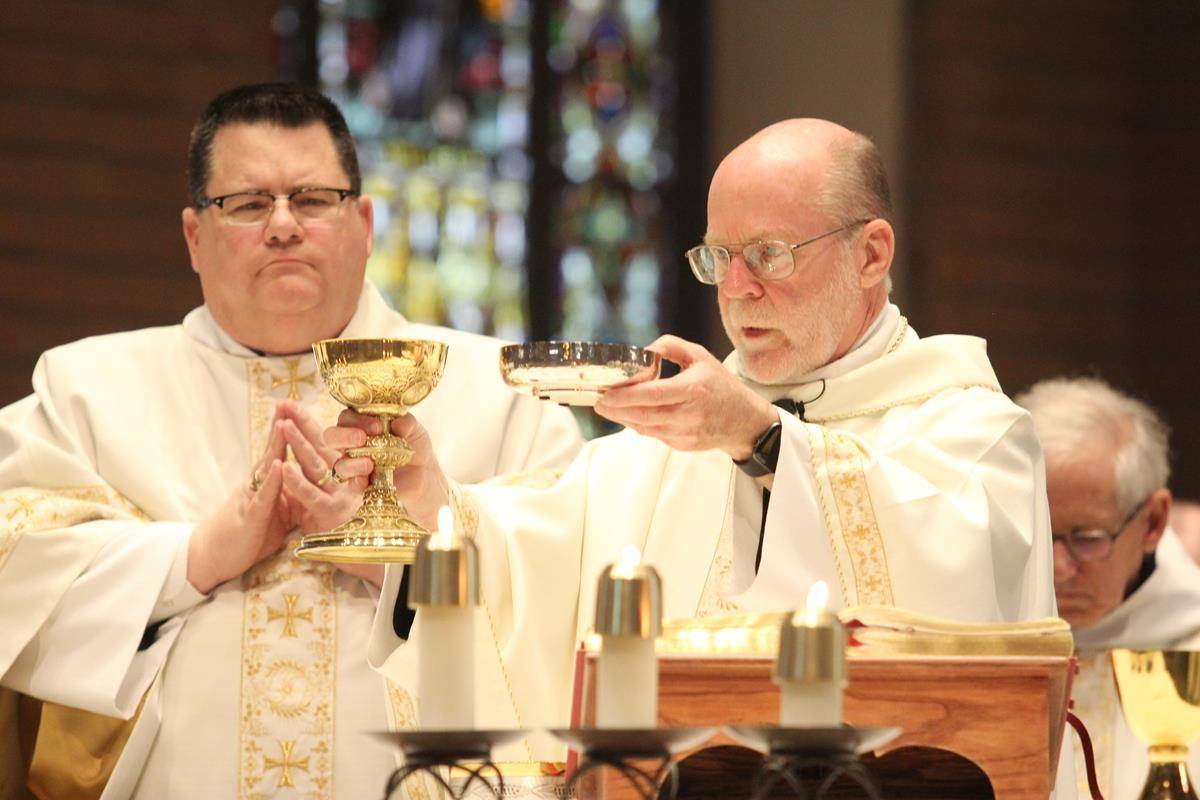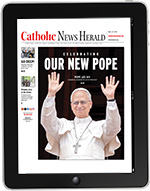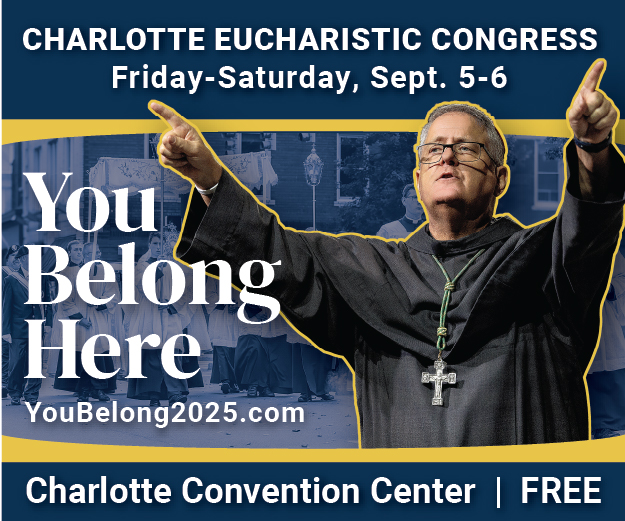‘Ora et Labora’
 Abbot Leo Haid, O.S.B., (center) is pictured with the visiting abbots at their nullius celebration at Belmont Abbey in 1910. Abbot Haid was to become one of the most pivotal figures in North Carolina Catholic history. He died in 1924 and is buried in Belmont Abbey Cemetery on the abbey campus.BELMONT — If not for the Benedictine monks of Belmont Abbey, the Church in North Carolina would not exist as we know it today.
Abbot Leo Haid, O.S.B., (center) is pictured with the visiting abbots at their nullius celebration at Belmont Abbey in 1910. Abbot Haid was to become one of the most pivotal figures in North Carolina Catholic history. He died in 1924 and is buried in Belmont Abbey Cemetery on the abbey campus.BELMONT — If not for the Benedictine monks of Belmont Abbey, the Church in North Carolina would not exist as we know it today.
The intrepid monks’ pioneering spirit attracted them to the wilderness of North Carolina 146 years ago, driven by the Benedictine motto: “Ora et Labora,” to pray and work here.
As the Diocese of Charlotte celebrates its 50th anniversary, we take a look back at how the Benedictines planted the seeds of Catholicism here and how they continue to cultivate the faith today.
HUMBLE BEGINNINGS
The history of the Benedictine monks’ presence here all began with a land deal.
In 1872, Rev. Dr. Jeremiah J. O’Connell, a circuit-riding priest who traveled tirelessly throughout the Carolinas and Georgia preaching and ministering to the sparse Catholic population, bought 500 acres of farmland near what today is Belmont. It was a bankruptcy sale, and he paid just $10.
During his extensive travels, Father O’Connell had realized the need for Catholic institutions to educate people and nurture vocations to the priesthood.
He approached the head of the Church in the Carolinas at the time – Bishop James Gibbons – and offered to donate the land if the bishop would agree to use it for a Catholic men’s college run by a religious order.
Bishop Gibbons – himself acutely aware of the need to provide religious education to Catholics living in the predominantly Protestant South – agreed. He then reached out to St. Vincent’s Archabbey in Latrobe, Pa., and asked them to set up a community of Benedictine monks and a college on the land.
St. Vincent’s Abbot Boniface Wimmer sent Benedictine Father Herman Wolfe to take a look at the property first, but the deal must have looked good because the monks agreed to the plan on Jan. 19, 1876.
Abbot Wimmer dispatched Father Wolfe back down to the Carolina wilderness with two students, and the monastery and school were founded on April 21, 1876.
By that fall, two more students joined them, along with five lay brothers – four to help run the farm and one to help run the school.
A few months later Abbot Wimmer visited the new school, named it St. Mary of Help Priory, directed that a chapel be built, and gave them an organ. On Sept. 8, the feast of the Nativity of Mary, the first Mass was offered in the new chapel.
By 1883, now Archabbot Wimmer realized for the new school and community to thrive, it would need strong local leadership, instead of being directed by the St. Vincent monks more than 400 miles away in Pennsylvania. He proposed to the St. Vincent monks that St. Mary’s Priory become its own Benedictine community.
The monks agreed, and on Dec. 19, 1884, St. Mary’s Priory became “Mary, Help of Christians Abbey.”
The monks of St. Vincent’s might have thought this new abbey in the wilds of western North Carolina was remote, even a place of exile. But eight of them bravely volunteered to move down, join the trail-blazing Father Wolfe, and form a new Benedictine community. They unanimously voted one of their own – Benedictine Father Leo Haid – to become the first abbot of their new community.
Abbot Leo Haid was to become one of the most pivotal figures in North Carolina Catholic history. Over the next 40 years, he would lead and nurture the growth of the faith here – through the economic depressions of the late 19th century, the industrial and political changes of the early 20th century, and the disruptions of World War I. Beyond serving as abbot, in 1888 he was appointed “vicar apostolic of North Carolina” by the Holy See, serving as leader of the Church for the entire state.
FAITHFUL PIONEERS
The monks who left the comfort of St. Vincent’s knew they were heading to a life of toil at the new community in Belmont. Benedictine monks take a vow of stability, which means a lifetime profession to a particular community. Even today, monks spend their lives working and praying at a particular monastery, and they eventually die and are buried there.
True to this Benedictine tradition, the pioneering monks of Belmont Abbey sought to create an enduring community. Abbot Haid believed sturdy brick buildings would express values like stability and beauty.
That spirit is apparent in the immense effort it took to build the abbey and college – literally from the ground up. They cleared the land and built each structure by hand, using timber they cut themselves and bricks they made by hand.
The largest structure they built was the abbey church, which still sits at the heart of the campus. Thanks to financial support from St. Katharine Drexel, the church was finished in 1894. A fire in 1900 caused significant damage to a college building, but the monks quickly rebuilt and classes resumed a few months later. The building is now on the National Register of Historic Places.
During Abbot Haid’s 39 years at the helm, 4,000 students passed through the college. The community grew to 85 monks serving the college and ministering to Catholics in the surrounding area. For decades, the monks regularly went beyond the confines of their monastery to build and staff churches across western North Carolina, serving the growing number of Catholic families in the absence of any other local Catholic institutions.
That special role was recognized by Pope Pius X, who in 1910 declared Belmont Abbey an “abbatia nullius” – an abbey outside the jurisdiction of any diocese. It meant the abbey church was elevated to that of a cathedral, and its abbot, to the rank of bishop.
The papal bull gave Abbot Haid and his successors jurisdiction over eight counties west of the abbey, answering directly to the Holy See. In 1977 the “abbatia nullius” was suppressed and all of the territory outside of the monastery was absorbed into the Charlotte diocese, but the abbey community and its college retain their independence.
THE ABBEY COMMUNITY TODAY
The abbey community – now comprised of 15 monks – remains rooted in its mission to provide a Catholic education. What was once called St. Mary’s College is today’s Belmont Abbey College, and it boasts 25 majors of study and an enrollment of 1,500 students. It is the only Catholic college between northern Virginia and Florida.
The abbey campus itself has grown to 700 acres. New dorms, a dining hall, a revitalized library and science building and sport fields now dot the landscape. The campus also includes a privately-run maternity home, MiraVia – an important support system for young mothers in need who want to pursue a college education.
Most recently, the monks of Belmont Abbey partnered with CaroMont Health to complement new healthcare degree programs offered at the college. A new hospital being built on the east side of the campus, CaroMont Regional Medical Center-Belmont, is set to open in mid-2023.
But the vibrant campus remains dominated by the historic Abbey Basilica – formally called Mary, Help of Christians Basilica. Beyond its purpose as a place of prayer, its brickwork speaks of permanence and trust in God’s providence, even as it has seen decades of change, generations of monks and tens of thousands of students.
That focus on worship of God lies at the heart of the Benedictine community.
“Monastic life is evangelizing,” says Benedictine Abbot Placid Solari, the eighth abbot of Belmont Abbey and chancellor of Belmont Abbey College. “It is a witness to the rest of the Church and the world, which is the Lordship of Jesus. The monks have devoted their lives to this, and first and foremost to prayer. That makes a statement to what is important in life – the importance and efficacy of prayer.
The Benedictine way of life has always been centered on prayer, no matter what work the monks are doing – teaching, serving the community, or taking care of the day-to-day tasks in the community, he says.
“The purpose (of coming to North Carolina) was to found a monastic community and school, but because of a lack of priests, the monks were pulled to help with pastoral care. We’re used to a flourishing diocese, but in those times it was very much mission territory.
“The school now flows out to primary witness of monastic life. It brings people together. Our community life and prayer, dedicated to life seeking God, is the evangelizing that raises questions to the world as to what is truly important.”
That spirit of faith is what drew Mooresville native David Brown to become a Benedictine monk in 1970. Growing up at St. Therese Parish, he enjoyed seeing the Benedictine monks who staffed the parish as needed. As a young man just out of college, he visited the abbey often for Vespers or Mass, or just to take time for reflection.
“I have been professed for over 50 years now. The peace and prayerful atmosphere are what attracted me,” he says. Through the decades Father David has served the college in instructional and administrative roles, served as procurator for the monastery, and assisted the local Catholic community in parishes when needed.
“I did what I promised I would do,” he explains simply. “Whatever I have contributed, my contributions have been second nature. It’s His work.”
Fellow monk Benedictine Father Christopher Kirchgessner agrees. Professed for nearly 50 years, he has taught at the college and assisted at parishes in Charlotte and Lincolnton.
“I think that our responsibility is to do the best we can to be faithful to what we promised,” he says. “That’s what they (early monks) did as well. It is to be faithful and trust that God is working.”
One of the younger monks, Benedictine Father Elias Correa-Torres, is grateful for the faithful legacy of the Benedictine community he joined in 2008. A former meteorologist, he now teaches monastic history to the monks in formation and several science courses at the college.
Reflecting on the lives of fellow monks who have since died, he says, “It was a lot of hard work. Monks like Father Kieran Neilson, Father Arthur Pendleton and
Father David Kessinger exemplified an ethic of work in the schools during week and then on weekends they served in the parishes. Then in summers when the schools were out, it was all hands on deck for maintenance around the abbey. Father Kieran described waxing all the floors and painting.”
“You worked all day, every day, all year round. That’s real dedication. They put blood, sweat and tears into everything. Everything we have is their legacy. The farm is blessed now in more ways than they could have dreamed of!”
— SueAnn Howell and Patricia Guilfoyle, Catholic News Herald. Photos provided by Belmont Abbey College and by SueAnn Howell, Catholic News Herald
Sources: “The First Hundred Years, Belmont Abbey College, 1876-1976” by Benedictine Father John P. Bradley; “Blessing The Years To Come: Belmont Abbey, A Pictorial Perspective” by Benedictine Father Paschal Baumstein; www.belmontabbey.org; and www.belmontabbeycollege.edu.
Learn more
At www.belmontabbey.org and www.belmontabbeycollege.edu: Discover more about the history of the Benedictine monks of Belmont Abbey, and how they and Belmont Abbey College continue to make an impact in our community
























